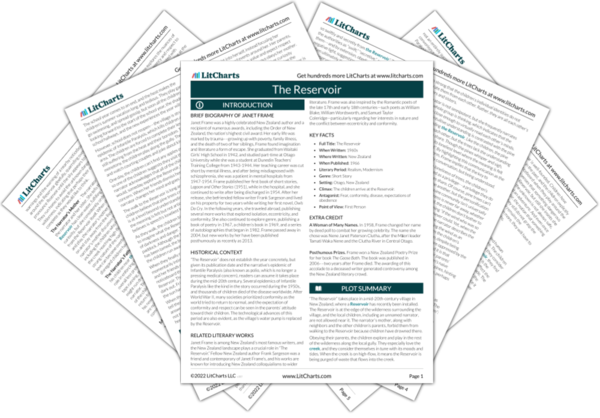Maturity
“The Reservoir” is a story about children, and also about childishness. The narrative emphasizes the innocence of its young protagonists––but it also points out that adults are not always wiser or more mature than the children they seek to control. By turning conventions of maturity on their head, Janet Frame explores the nuances of childhood innocence while also granting agency and respect to the children in her story. The children are fascinated with “adult” experiences…
read analysis of MaturityIndependence vs. Obedience
The theme of control runs through “The Reservoir.” Frame repeats the phrase “for so long we obeyed” throughout the story to underline how much of the narrator’s life is spent following orders, and the first paragraph presents the idea that animals and children must show respect to adults. Setting animals and children on the same level dehumanizes the children, implying that they are like livestock that must be herded. The metaphorical connection between…
read analysis of Independence vs. ObedienceFear, Curiosity, and Exploration
Just as the Reservoir provides the town with water, it is a source of inspiration for the local children’s imaginations. The narrator imagines it as “a bundle of darkness” with a sleeping beast beneath its waters and “great wheels which peeled and sliced you like an apple.” Yet this fear doesn’t stop the children from exploring the Reservoir––in fact, it does the opposite. The mysterious Reservoir and its surrounding stories stir the children’s curiosity, demonstrating…
read analysis of Fear, Curiosity, and Exploration
Friendship and Loneliness
The children in “The Reservoir” often act and think as one entity, and the narrator uses the pronoun “we” more often than “I” to describe how the story progresses. The rapidly-paced conversations the children have throughout the story rarely have dialogue tags. On the rare occasion the speaker is noted, the speaker is simply called “someone,” and one dialogue tag refers to the speaker as “someone––brother or sister.” The bond between the children is so…
read analysis of Friendship and LonelinessNature vs Modernization
Throughout the story, nature comes across as dangerous, petty, or even actively malicious. The world, according to the narrator, is “full of alarm”: sunstroke, lightning, tidal waves, and the summer sun that “wait[s] to pounce” all present a threat to the residents of the village. In light of these dangers, the Reservoir represents human efforts to dominate part of the natural world. Even the children share this dominating instinct; the narrator wishes to “…
read analysis of Nature vs Modernization











